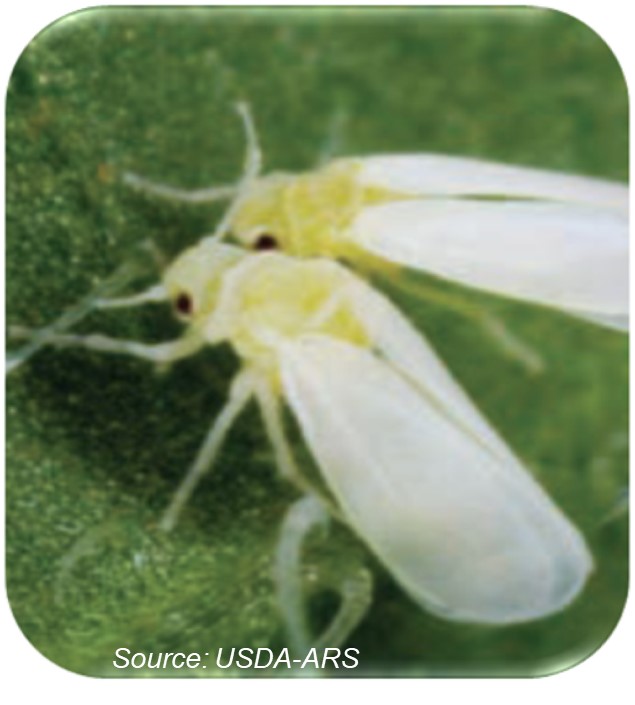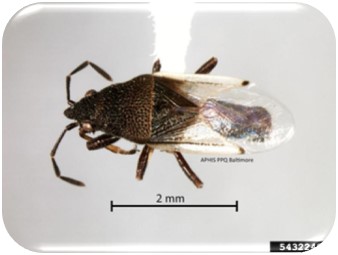Pest of Concern: Cotton jassid (Amrasca biguttula)
Cotton Seed Bug, Oxycarenus hyalinipennis Detections Updates.
The Cotton Pest Control Program is overseen by the California Cotton Pest Control Board (CCPCB), which makes recommendations to the CDFA Secretary on matters concerning the Program. The CCPCB is comprised of nine cotton industry members from counties across the State and one public member. All CCPCB meetings are open to the public and information regarding upcoming meetings can be found on the Plant Health and Pest Prevention Services' Meetings web page.
Reports
Cotton Pest Control Program Reports
2023
2025
Silverleaf Whitefly Reports
2020
2021
Cotton Seed Bug Reports
Cotton Pest Information
Pink Bollworm

The pink bollworm causes damage to cotton crops by its larvae burrowing into cotton bolls and feeding on the seeds. The pink bollworm adult moths are 12.7 mm long and grayish brown, while the larvae are small white caterpillars that turn pink as they mature.
UC IPM Pest Management Guidelines: Cotton. UC ANR Publication 3444. Accessed 8 February 2022.
Silverleaf Whitefly

The silverleaf whitefly causes damage to cotton crops by producing sticky honeydew, which can lead to “sticky cotton” during the ginning process, and by feeding on the cotton plants. Adult silverleaf whiteflies are 1.5 mm long with white winged insects, while the pupae are white with red eyes and an oval shape.
UC IPM Pest Management Guidelines: Cotton. UC ANR Publication 3443. Accessed 8 February 2022.
Cotton Seed Bug

Cotton seed bugs damage cotton crops by laying eggs in cotton bolls where the nymphs feed on cotton seeds. Adult cotton seed bugs are 4-5 mm long with white glassy wings whose bodies can be colored brown to black. Nymphs are small with an orange red body and develops a darker red abdomen as it matures. Technical Bulletin- Oxycarenus hyalinipennis (Costa) (Hemiptera: Service Oxycarenidae) Cotton seed bug. United States department of Agriculture, April 23, 2021.
Technical Bulletin - Oxycarenus hyalinipennis (Costa) (Hemiptera: Service Oxycarenidae) Cotton seed bug. United States department of Agriculture, April 23, 2021.
Program Details
Cotton Mapping
All surveys and trapping rely on knowing where the cotton fields are throughout the State. In the beginning of the season, the Program uses GIS mapping technology and County Agriculture maps to find and record all the cotton fields throughout the State. The Program continues to track changes to cotton fields throughout the rest of the cotton growing season.
Pink Bollworm Trapping
The Cotton Pest Control Program, originally the Pink Bollworm (PBW) Program, began in 1967 with the goal of using integrated pest management to control the PBW populations in California. In 2018, the United States Department of Agriculture declared eradication of PBW. Since then, the Program’s main functions have expanded to include not only ongoing trap monitoring operations for PBW, but also monitoring and survey operations for additional cotton pests, such as silverleaf whitefly and cotton seed bug.

Trap monitoring to detect adult pink bollworm moths is ongoing in order for the Program to provide industry with an early warning in the case of a reintroduction of the pink bollworm to California.
The Program uses a delta trap made of cardboard that is sticky on all three inside surfaces. A pheromone lure that attracts male pink bollworm moths is placed inside of the trap. The traps are placed over the first cotton plant at the end of a row or the first plant at the edge of the field. The trap is suspended over the cotton plant in a manner that permits the trapper to service it without touching the cotton foliage. Traps are serviced biweekly in the San Joaquin Valley and weekly in Southern California. If they contain moths that look similar to pink bollworm, the trap is replaced and the traps containing specimens are sent to a laboratory for identification by an entomologist.
Silverleaf Whitefly Survey
The silverleaf whitefly (SLWF) survey is conducted by Program personnel collecting samples from designated sites at ten percent of all cotton fields in each county in the San Joaquin Valley. The main purpose of the survey is to collect data on the temporal and geographical distribution of the SLWF, an invasive pest whose hosts include cotton and several other agricultural and native plant species. The SLWF causes damage to cotton crops in several ways, the foremost method is through the secretion of honeydew onto the leaves which can lead to “sticky cotton” during the ginning process, and also promotes the growth of the fungal disease, black sooty mold. Therefore, this survey includes the screening of sampled leaves for honeydew secretion and black sooty mold. Other whitefly species can be indicative of the presence or the future presence of SLWF species. Accordingly, this survey screens sampled leaves for other whitefly species. Aphids were included in this survey because, similarly to SLWF, aphids are a pest that secrete honeydew which promotes the growth of black sooty mold. In addition to SLWF, aphids, honeydew, black sooty mold, and other whitefly species, the survey includes the inspection of sampled leaves for mites and armyworm, which are other pest species commonly found on cotton leaves. All sampled leaves are visually inspected with a microscope to identify the aforementioned pest species and pest indicators.
Cotton Seed Bug Survey
The cotton seed bug (CSB) survey is based off the United State Department of Agriculture’s New Pest Response Guidelines for the CSB. Program personnel conduct visual inspections and collect cotton boll samples from designated cotton field sample sites at ten percent of all cotton acreage in each county throughout the State. For each cotton field sample site, a set number cotton bolls are removed depending on the acreage of the sample site.
The cotton plants are chosen by randomly selecting an equal amount of plants from each of the following sample site orientations: north, south, east, and west. The sample bags are then tied, double bagged, labelled, and sent to be processed at CDFA’s Plant Pest Diagnostics Center.
Program Contact
Roja Ramani Samudrala, Senior Environmental Scientist: rojaramani.samudrala@cdfa.ca.gov
